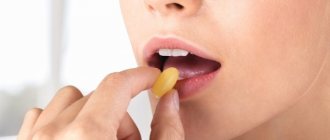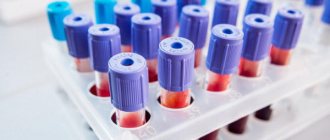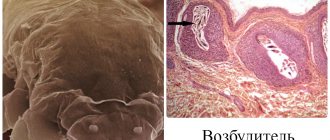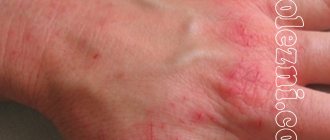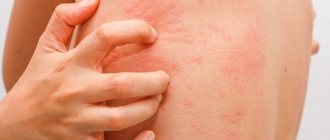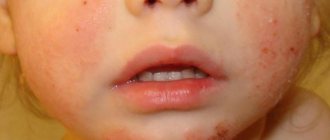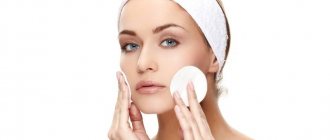Seborrhea on the face (briefly about the disease)
First of all, you need to understand what it is - seborrhea on the face. It is not so difficult to recognize it, since it manifests itself as red inflammatory foci on the skin and hair, causing significant discomfort - unbearable itching, bleeding wounds after scratching.
If a secondary infection occurs, pustules may appear.
Usually the disease originates in the hair. This becomes noticeable when you need to wash your hair frequently due to its excessive greasiness. This is often accompanied by the appearance of dandruff and increased hair loss.
True, after treatment their growth is restored. If you ignore this picture, then seborrhea spreads to the face: eyebrows, bridge of the nose, wings of the nose and to the areas behind the ears.
Seborrheic dermatitis most often affects young people during puberty. However, as they grow older, the functions of their sebaceous glands begin to stabilize.
As a result, seborrhea goes away on its own. If the attack continues to attack from year to year, then it is worth worrying about the cause of this phenomenon - it is recommended to visit a dermatologist.
Causes
The main factor in the development of seborrhea is an increase in the growth of the colony of the yeast-like fungus Pityrosporum ovale. The growth of the fungus and, as a result, the development of seborrhea occurs against the background of the following factors:
- metabolic disease;
- hormonal disorders;
- heredity;
- reduced immunity;
- neglect of hygiene;
- psycho-emotional stress;
- improper skin care;
- excessive tanning;
- poor nutrition.
How to treat the disease?
As it turns out, seborrhea can be either an independent pathology or a concomitant one (provoked by others). Therefore, it is important to find and eliminate the original source, otherwise no treatment will give the desired result.
Despite the very deplorable clinical picture, you can get rid of such a nuisance.
So how to treat seborrhea on the face? Treatment is selected depending on the type. First, local therapy is used. In a situation where the hair and face are affected by oily seborrhea:
- Use appropriate shampoos (with a neutral pH), creams and peelings, which contain substances that suppress pathogenic fungus. They also slow down the increased activity of the sebaceous glands.
- The epidermis is systematically treated with salicylic or camphor alcohol. Baby powder or zinc (sulfur) powder dries well.
- Cosmetic and medicinal products based on tar are used.
With the dry type of the disease, there is no need for long-term use of topical medications. But you will need to wipe the skin with boric or salicylic acid, sulfur-containing ointment, creams containing vitamins A, F and E.
Herbal decoctions and infusions of anti-inflammatory properties are no less effective in restoring the health of the epidermis.
When a mixed type of disease is diagnosed, it is recommended to use combined medicinal formulations.
Symptoms
Seborrhea can be divided into two main types: dry and oily. Although they are considered parts of the same pathology, their symptoms can vary greatly . Therefore, we will analyze them separately.
So, the symptoms of oily seborrhea:
- Sticky, yellowish, large scales . They are difficult to separate from the skin. These particles resemble dough or paste in consistency. The tactile sensations when touching them with your hands are extremely unpleasant.
- Hair gets dirty very quickly and becomes covered with dust. At the roots they stick together into one bunch, at the ends, on the contrary, they separate.
- Mild itching may occur.
- The pores expand significantly.
- The sebaceous secretion loses its antiseptic properties, which causes acne .
- Small to medium amount of dandruff.
Find out what to do if scabs appear on your head, as well as if your hair starts to fall out?
Symptoms of dry seborrhea:
- The skin dries out, cracks, and microtraumas occur on it . This is accompanied by severe itching.
- Hair becomes dry and brittle ; due to weakening of hair follicles and drying of the skin, the process of hair loss begins.
- A lot of dandruff is formed . Peeling of the scalp leads to abundant “precipitation” in the form of white and yellow flakes.
- Layers are removed very easily.
- Large red spots appear - seboroids .
What to do if there is a lot of dandruff, dry skin and severe itching?
Typically, the dry form of the disease occurs during the development of the fatty form . This is due to the fact that excessive sebum secretion leads to acne, infection, clogging of pores with layered scales and, as a result, a sharp decrease in the secretion of fluid by the glands.
On a note ! Is seborrhea contagious or not and how is seborrhea transmitted? This is not a contagious disease. Despite the fact that it is caused by a fungus, which can indeed be transmitted from person to person, the main factor in the disturbance of sebaceous secretion is not the fungus itself, but the hormonal, immune and other factors that accompany it.
Systems approach
Considering the cause of the development of seborrheic dermatitis, the treatment course may include the following steps:
- They take medications that have a positive effect on the skin glands: potassium bicarbonate, sodium thiosulfate, sulfur. They have antiseptic, anti-inflammatory and antiallergic effects. Thanks to this, scabies, redness are relieved and toxins are removed from the body.
- Drink vitamin and mineral complexes to strengthen the body's immune capabilities.
- Get rid of problems with the gastrointestinal tract. Treatment prescriptions are issued by a gastroenterologist based on examinations and tests. Usually, medications are prescribed that are choleretic and help normalize digestion.
- Eliminate disorders of the central nervous and endocrine systems if they provoke seborrhea.
- They resort to ultraviolet irradiation in small dosages to suppress itching.
- Corticosteroid medications are used (externally). More often they are necessary when the disease becomes chronic or with repeated relapses. You cannot resort to such treatment for a long period, as it can become addictive and cause side effects.
- They adhere to a special diet and completely exclude alcoholic beverages.
Localization
Seborrheic dermatitis of the skin occurs in those areas of the body where most of the sebaceous glands are concentrated:
- cheekbones;
- chin;
- nasolabial triangle;
- eyebrows, eyelashes and forehead;
- nose;
- scalp and skin behind the ears;
- shoulders and interscapular area;
- breast.
But this is not a complete list of places where seborrhea appears. Other areas with increased sebum secretion may also be involved in the pathogenic process. In particularly difficult cases, a generalized type of eczema develops, affecting most of the body.
What to eat while undergoing treatment
It has been scientifically proven that the condition of the skin depends on the quality of nutrition. Thus, carbohydrate-containing products increase sebum secretion. Therefore, they should be removed from the diet.
The key principles of the diet for seborrheic lesions are as follows:
- eat often, but in limited portions;
- include bran in the menu, which productively cleanses the intestines and prevents the accumulation of feces on the walls;
- consume more fiber (found in fresh vegetables and fruits) so that you can go to the toilet more often every day;
- avoid eating: fatty foods, smoked meats and canned foods;
- once a week they arrange vegetable, fruit or kefir fasting days, but not on water;
- dishes are steamed, boiled or baked;
- minimize the consumption of salt, seasonings, sweets and baked goods.
The following should prevail in the everyday diet: soups, fermented milk products, cereals, vegetables, fruits.
Question answer
Quite often, for oily or dry seborrhea, various ointments are prescribed.
To relieve itching and reduce redness, doctors prescribe the antiseptic Flucinar and the hormonal drug Advantan. In addition, the doctor can prescribe various ointments, for example, Lamisil, naphthalene ointment and others. A person who develops seborrhea may experience an acute inflammatory reaction. In this case, you need to quickly relieve the symptoms. For this purpose, anti-allergy medications and non-steroidal drugs are taken. There are situations when taking corticosteroids or antibacterial drugs is required.
Doctors often advise going for ozone therapy. This procedure has a positive effect on the skin, helps remove harmful substances, improves blood microcirculation, and fights harmful microorganisms. For oily seborrhea, facial cleansing may be prescribed. But it must be carried out by a doctor with the appropriate skills.
Diagnostics
Diagnostic measures begin with a detailed interview with the patient and collection of an anamnesis of the disease. A visual examination of the skin and hair reveals irritation and peeling of the epithelium, increased sebum secretion, and dandruff.
Additional studies will help clarify the diagnosis and differentiate (isolate) seborrhea from other dermatological diseases:
- microscopy;
- dermatoscopy;
- general blood test and biochemistry;
- spectral examination.
To determine the causes of seborrhea, the patient is prescribed endoscopy, sugar testing, and hormonal levels. Such detailed diagnosis of skin lesions is necessary to determine the complete picture of the disease and prescribe optimal therapy.
Folk remedies
An exacerbation of seborrhea is usually observed in the autumn-winter period. Therefore, it is recommended to prepare for this in advance, in case of predisposition. Here folk recipes with medicinal herbs will come to the rescue. They can be collected and prepared in the summer.
The most effective recipes are presented in the table:
| Means | Preparation | Application |
| Series | Brew 20 grams of herb in a glass of boiling water. Insist for 20 minutes. | Wipe the affected areas or apply lotions. You can wash your face with the decoction. |
| Elecampane, burdock, St. John's wort | You will need roots that are ground to a fine powder. Measure out 10–15 g of each type and steam it with boiling water in an amount of 170–180 ml. Leave for 20 minutes. | Rub into the skin and hairy area. |
| Dandelions | Squeeze out the juice and mix (15 ml) with 120–130 ml of boiled water. | Drink 3 times a day before meals. |
| Nettle | Combine water and vinegar in equal parts. This liquid is poured into 20g of dry nettle leaves and heated for a quarter of an hour. | Lubricate problem parts of the body with this medicine. Used for oily seborrhea. |
| St. John's wort | An ointment is prepared to get rid of the dry type of the disease. To do this, twist the leaves and stems of the grass and squeeze out the juice. Place it on the fire and boil it down by half. After this, combine with softened butter. | Lubricate the lesions. |
| Plantain | Juice is made from plantain. Add Vaseline (20 g). Leave in cool place for an hour. | Apply to the face after evening and morning washing. |
| Lemon | Squeeze out the lemon juice and mix in: liquid glycerin - 1 tsp, alcohol - 110 ml, chicken protein. | Rubbing is indicated for oily seborrhea |
| Aloe | Several leaves are peeled and chopped to a pasty consistency. Add 150 ml of boiling water, place on fire and keep for a quarter of an hour. | Treat the epidermis for acne and oily sheen. |
| Kalina | Squeeze juice from berries. | Use it to treat oily seborrhea. |
Prevention
Preventive measures can minimize the manifestation of seborrheic symptoms:
- regularly take care of your face using cosmetics appropriate for your specific skin type;
- give up bad habits such as smoking and drinking alcohol;
- take vitamin and mineral supplements from time to time, especially in autumn and spring;
- include brewer's yeast, which has a rich biochemical composition, in the daily menu;
- reconsider the daily diet, which includes high-quality and healthy products.
Why does seborrheic dermatitis occur?
The main condition for the development of the disease is the activation of the fungus Pitirosporum ovale, which lives on human skin, making up approximately 40% of the composition of healthy skin microflora. The microorganism is suppressed by organic secretions and beneficial bacteria, and therefore does not provoke any problems.
Trouble occurs when there are too many bacteria. The growth and reproduction of the pathogen provokes a change in the composition of sweat and sebum. Changes occur due to:
- improper hygiene;
- disruptions in the functioning of the immune system;
- endocrinological diseases;
- chronic infectious diseases;
- exhaustion of the body.
What to do if you have dermatitis?!
|
Under such conditions, the secretions of the skin, designed to moisturize it and suppress harmful bacteria, change, and the fungus uses them as habitat and food. By multiplying, microorganisms inhabit the gland ducts and hair follicles and change their functioning. Too much or too little sebaceous secretion is produced. Both options have an extremely adverse effect on the condition of the facial skin.
Due to failures in the protective function of the epidermis, hyperkeratosis develops - accelerated division of skin cells and their keratinization. Then many dense horny scales appear on the integument. The plates disrupt the process of self-cleaning of the dermis, aggravating the problems. Dryness or oiliness and a large number of dead cells become favorable conditions for the proliferation of other fungi and pathogenic bacteria. Penetrating into the skin, they provoke irritation, inflammation, and purulent processes.
Seborrheic dermatitis occurs with relapses and exacerbations. In their alternation, the psycho-emotional state of the patient plays a key role. After stress and overwork, the area of rashes increases.
Expert opinion
- Cosmetologist
- Surgeon
Michelle Ellern
practicing cosmetologist-dermatologist
It is undesirable to develop seborrhea on the face, as you can incur much more serious health problems. The chemically altered secretion secreted by the skin creates a favorable environment for the addition of other dangerous infections. For example, seborrhea is usually accompanied by acne and boils on the face.
Theda Contis
plastic surgeon
The mixed form of pathology has similar symptoms to other diseases. For example, psoriasis, candidiasis, and lichen manifest themselves in the same way. This is why many people confuse these diseases. As soon as you notice suspicious rashes on your body or face, go to the doctor. Only a doctor will be able to determine exactly what kind of pathology it is and prescribe proper treatment.
Seborrhea on the face is a rather serious ailment, which should preferably be treated under the supervision and as prescribed by a dermatologist.
An illiterate independent approach threatens with not very rosy consequences - residual scars and scars that last a lifetime.

